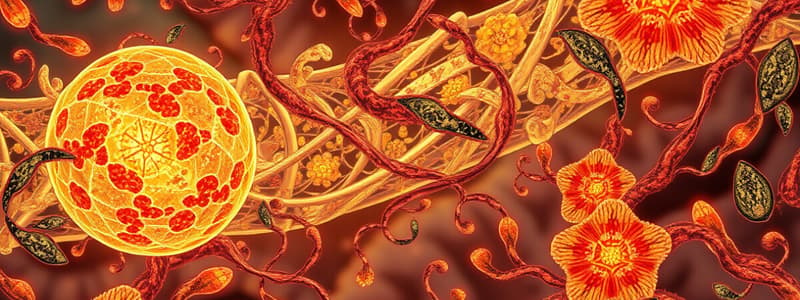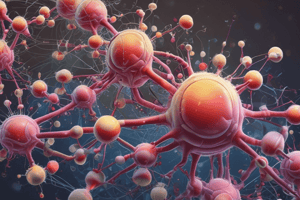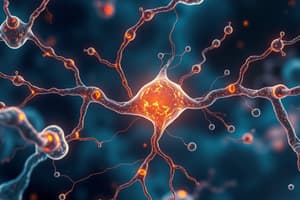Podcast
Questions and Answers
What is the primary physiological role of prostaglandins in the body?
What is the primary physiological role of prostaglandins in the body?
- Smooth muscle contraction during menstruation and labor (correct)
- Maintenance of calcium levels in bones
- Storage of fatty acids
- Regulation of blood glucose levels
Which pathway is NOT involved in the synthesis of eicosanoids?
Which pathway is NOT involved in the synthesis of eicosanoids?
- Cyclooxygenase pathway
- Peptide synthesis pathway (correct)
- Lipoxygenase pathway
- Cytochrome P450 system
What is the structure characteristic of thromboxanes?
What is the structure characteristic of thromboxanes?
- Three interconnected five-membered rings
- A six-membered ring that includes an oxygen atom (correct)
- No structural rings, linear configuration
- Five-membered carbon ring without oxygen
How are eicosanoids produced within the body?
How are eicosanoids produced within the body?
Which cellular response is specifically attributed to the action of leukotrienes?
Which cellular response is specifically attributed to the action of leukotrienes?
What function do eicosanoids NOT have in the body?
What function do eicosanoids NOT have in the body?
Which of the following best describes the relationship between eicosanoids and G-protein coupled receptors?
Which of the following best describes the relationship between eicosanoids and G-protein coupled receptors?
Which of the following is a primary function of thromboxanes?
Which of the following is a primary function of thromboxanes?
What property of eicosanoids allows them to have diverse tissue functions?
What property of eicosanoids allows them to have diverse tissue functions?
What is the primary effect of thromboxane A2 in relation to platelet function?
What is the primary effect of thromboxane A2 in relation to platelet function?
Which of the following statements regarding prostacyclin (PGI2) is correct?
Which of the following statements regarding prostacyclin (PGI2) is correct?
What is the mechanism of action of low-dose aspirin therapy?
What is the mechanism of action of low-dose aspirin therapy?
How does the inhibition of COX-1 by NSAIDs affect platelet function?
How does the inhibition of COX-1 by NSAIDs affect platelet function?
What is the significance of platelet renewal in relation to aspirin treatment?
What is the significance of platelet renewal in relation to aspirin treatment?
What role does cortisol play in platelet homeostasis?
What role does cortisol play in platelet homeostasis?
What is the primary function of COX-1 in the body?
What is the primary function of COX-1 in the body?
What type of inhibitor is celecoxib categorized as?
What type of inhibitor is celecoxib categorized as?
Which fatty acid serves as a dietary precursor for the synthesis of prostaglandins?
Which fatty acid serves as a dietary precursor for the synthesis of prostaglandins?
How does ibuprofen primarily act on PGH synthase?
How does ibuprofen primarily act on PGH synthase?
What is the primary role of 5-lipoxygenase in the lipoxygenase pathway?
What is the primary role of 5-lipoxygenase in the lipoxygenase pathway?
Why does acetaminophen have poor ability to inhibit COX in high concentrations of peroxides?
Why does acetaminophen have poor ability to inhibit COX in high concentrations of peroxides?
What pathway does the lipoxygenase family affect primarily?
What pathway does the lipoxygenase family affect primarily?
What influences the activity of COX-2 in tissues?
What influences the activity of COX-2 in tissues?
Which of the following statements best describes leukotrienes?
Which of the following statements best describes leukotrienes?
What determines the rate of product formation from arachidonic acid?
What determines the rate of product formation from arachidonic acid?
Which enzyme is responsible for hydrolyzing arachidonate?
Which enzyme is responsible for hydrolyzing arachidonate?
How is arachidonic acid stored in cell membranes?
How is arachidonic acid stored in cell membranes?
What is a primary precursor to thromboxanes and prostaglandins?
What is a primary precursor to thromboxanes and prostaglandins?
Which of the following stimulates arachidonic acid release in specific cell types?
Which of the following stimulates arachidonic acid release in specific cell types?
What is the role of phospholipase C regarding phosphatidylinositol?
What is the role of phospholipase C regarding phosphatidylinositol?
Which type of cell would bradykinin specifically stimulate for arachidonic acid release?
Which type of cell would bradykinin specifically stimulate for arachidonic acid release?
Which of the following is NOT a product derived from arachidonic acid metabolism?
Which of the following is NOT a product derived from arachidonic acid metabolism?
Which phospholipase is primarily involved in the release of arachidonic acid?
Which phospholipase is primarily involved in the release of arachidonic acid?
What role does thrombin play regarding arachidonic acid?
What role does thrombin play regarding arachidonic acid?
What is indicated by a subscript in nomenclature?
What is indicated by a subscript in nomenclature?
Which of the following NSAIDs is specifically associated with increased leukotriene levels?
Which of the following NSAIDs is specifically associated with increased leukotriene levels?
How does the structure of Hydroperoxy-eicosatetraenoic acid differ from other eicosanoids?
How does the structure of Hydroperoxy-eicosatetraenoic acid differ from other eicosanoids?
What effect do NSAIDs such as aspirin have on the blood flow at a clot site?
What effect do NSAIDs such as aspirin have on the blood flow at a clot site?
Substitutions at which positions are indicated for Hydroperoxy in nomenclature?
Substitutions at which positions are indicated for Hydroperoxy in nomenclature?
Which of the following is NOT a recognized nonsteroidal anti-inflammatory drug (NSAID)?
Which of the following is NOT a recognized nonsteroidal anti-inflammatory drug (NSAID)?
What is the primary biological activity associated with Hydroperoxy-eicosatetraenoic acid?
What is the primary biological activity associated with Hydroperoxy-eicosatetraenoic acid?
Which NSAID is known for potentially triggering asthma attacks?
Which NSAID is known for potentially triggering asthma attacks?
What is a common use of eicosanoids in the body?
What is a common use of eicosanoids in the body?
What does the additional capital letter signify in the nomenclature of compounds?
What does the additional capital letter signify in the nomenclature of compounds?
Flashcards are hidden until you start studying
Study Notes
Eicosanoids Function
- Derived from arachidonic acid, a 20-carbon polyunsaturated fatty acid.
- Not stored but synthesized on demand, responding to cellular signaling.
- Mediated by G-protein coupled receptors, influencing various physiological functions.
Functions of Eicosanoids
- Reproductive functions including smooth muscle contraction during menstruation and labor.
- Modulation of inflammation, resulting in fever and pain responses.
- Involvement in blood clot formation and regulation of blood flow to specific organs.
- Influence on wake-sleep cycles and responsiveness to hormones like epinephrine and glucagon.
- Regulation of gastric acid secretion and blood pressure.
Pathways for Eicosanoid Synthesis
- Cyclooxygenase Pathway: Produces prostaglandins and thromboxanes.
- Lipoxygenase Pathway: Generates leukotrienes, HETE (Hydroxyeicosatetraenoic acid), and lipoxins.
- Cytochrome P450 System: Synthesizes epoxides, HETE, and diHETE.
Prostaglandins
- Composed of a 20-carbon fatty acid structure with a 5-membered internal carbon ring and a hydroxyl group at carbon 15.
- Nomenclature begins with "PG" followed by capital letters indicating specific substitutions.
Thromboxanes
- Feature a 6-membered ring including an oxygen atom.
- Nomenclature uses "TX" with capital letters for ring substitutions and subscripts indicating unsaturated bonds.
- Function primarily in blood clot formation and reduction of blood flow to injury sites.
Hydroperoxy-eicosatetraenoic Acid (HETE)
- Hydroxyl fatty acid derivative of arachidonic acid, lacking a ring structure.
- Nomenclature includes hydroperoxy substitutions at positions 5, 12, and 15.
Metabolism of Eicosanoids
- Arachidonic acid is a precursor for major eicosanoids, stored as phospholipid esters in cell membranes.
- Released by phospholipase A2 when stimulated, influencing the rate of eicosanoid synthesis.
- Specific agonists like thrombin and bradykinin stimulate arachidonic acid production.
Synthesis of Eicosanoids
- Linoleic acid, an omega-6 fatty acid, is essential for prostaglandin production.
- Arachidonic acid is derived from dietary intake of linoleic acid.
- Prostaglandin H2 (PGH2) synthesized through oxidative cyclization of arachidonic acid, requiring oxygen and reducing agents.
Inhibition of Eicosanoid Synthesis
- Nonsteroidal anti-inflammatory drugs (NSAIDs) including aspirin, ibuprofen inhibit cyclooxygenase (COX) enzymes, shifting production to lipoxygenase pathways.
- NSAIDs can potentially induce asthma attacks through increased leukotriene synthesis.
Roles of Prostaglandins in Platelet Homeostasis
- Thromboxane A2 (TXA2): Promotes platelet aggregation and vasoconstriction; synthesized by COX-1 in activated platelets.
- Prostacyclin (PGI2): Inhibits platelet aggregation and promotes vasodilation; produced by COX-2 in vascular endothelium.
Aspirin and Its Effects
- Provides antithrombogenic effects by irreversibly acetylating COX enzymes, reducing TXA2 synthesis in platelets while affecting PGI2 synthesis in endothelial cells.
- Low-dose aspirin therapy lowers the risk of stroke and heart attacks by decreasing thrombus formation.
Studying That Suits You
Use AI to generate personalized quizzes and flashcards to suit your learning preferences.




